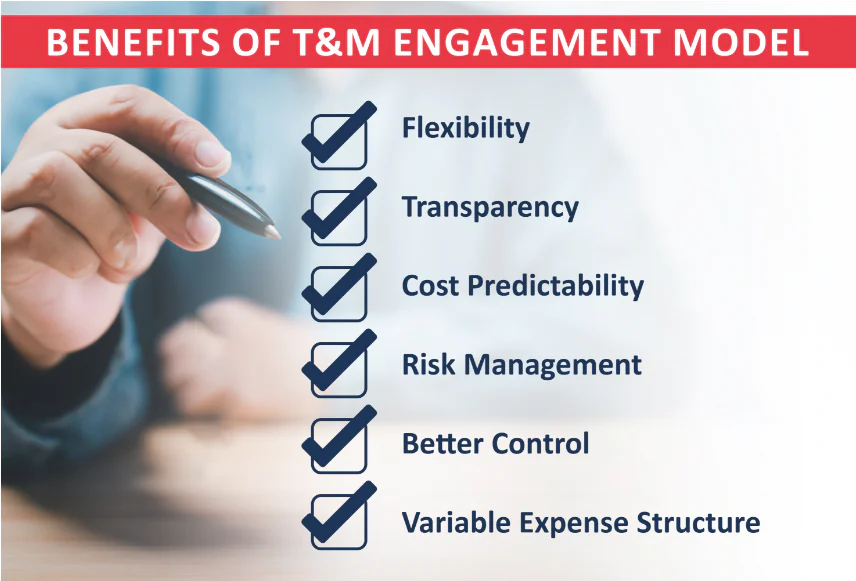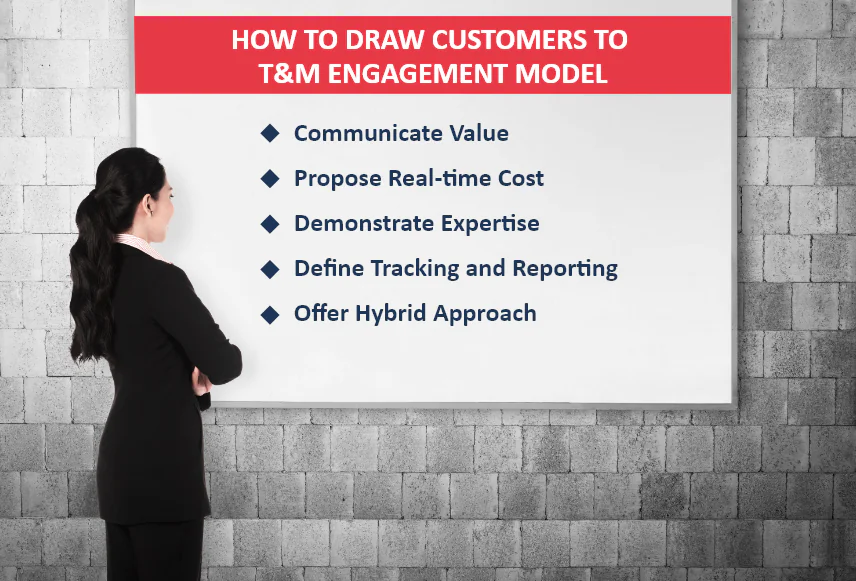
What is a Time and Material Engagement Model?
A T&M or Time and Material engagement is a pricing model used in professional services, such as consulting or software development. In this model, the customer pays for the actual time that the team spends working on the project, along with the materials or resources utilized by them.
In other words, the total cost of the project may vary based on the amount of time and resources needed to complete it. Therefore, it is essential for the customer and the team to clearly communicate and collaborate to ensure the project stays within the set budget and on track.
Our today’s blog post is all about exploring the significance of a time and material engagement model and why should you need to choose it over a fixed bid model. But first, let’s understand the scenarios where selecting this pricing model can provide the greatest benefits.
When to Use Time and Material Engagement Model?
A time and material engagement model allows clients to pay only for the completed work rather than a fixed price for the entire project. It provides the flexibility and adaptability needed to navigate the ever-changing business requirements.
There are several situations in which this engagement model might be the best choice for a business. Let’s take a look at a few of them.
1. Unclear Project Scope
A time and material engagement model could be a go-to option for projects with unclear requirements. It allows for an agile adaptation to uncertain project scopes. It enables the team to adjust priorities, resources, and deliverables as the project progresses, ensuring alignment with the evolving requirements.
“The Time And Material Engagement Model Is A Strategic Choice For Projects That Require Close Collaboration, Iterative Development, And A Flexible Cost Structure To Effectively Deliver Value In An Environment Of Uncertainty.”
2. Scarcely Available Expertise
A time and material engagement model can help meet the requirements of a project that demands the involvement of skilled professionals who are not readily available. It allows the client to hire the necessary expertise on an as-needed basis.
3. Maintaining a Core Team
When the team is working on a strategic initiative or need deep business and customer understanding, having a time and material model to maintain a dedicated core team.
4. Having Deep Product Knowledge
In projects where deep product knowledge helps improve productivity, decision making, and quality standards, having a dedicated team in a time and material model is helpful.
5. Projects with Short Timelines
In projects with short timelines, a time and material engagement model offers the advantage of immediate access to specialized expertise. With the ability to quickly onboard additional resources as needed, this model supports the efficient allocation of manpower and ensures that the project stays on track.
6. Flexible Remote Team Extension
A time and material engagement model can benefit projects that seek an extension of a remotely working dedicated team. It enables businesses to access specialized talent remotely, maintain cost control, and enhance productivity by flexibly extending their core team.
6 Benefits of Time and Material Engagement for Customer
Now that you know what is time and material engagement model and when to use it, we can move forward to understanding its benefits for the customers. The benefits are not limited to but include the following.

1. Flexibility
A time and material engagement model allows for more flexibility during the project, as the scope of work can be adjusted as needed. This can be useful in situations where the project requirements still need to be fully understood at the outset or if there are changes to the project scope during the work.
2. Accountability
With a time and material engagement contract, the client has a clear understanding of the actual time and materials used, as well as the associated costs. This can help improve communication between the client and vendor.
3. Cost Predictability
Indeed, the total cost of a time and material project may take time to predict upfront. However, the client gets the privilege of controlling costs by monitoring the time and materials used and making adjustments as needed.
4. Risk Management
A time and material engagement contract allows the vendor to share project risk with the client by compensating the vendor based on actual time and materials. This can help reduce the risk of cost overruns for the client.
5. Enhanced Team Control
A time and material engagement model provides better control over the team by offering increased visibility and agility. It helps clients closely monitor the team’s progress, track their hours, and ensure efficient resource allocation.
6. Variable Expense Structure
With a time and material engagement model with a vendor in place, the finance team can rely on a variable expense structure instead of a fixed cost of full-time equivalent. They can identify areas where expenses can be reduced or optimized, leading to improved profitability.
Get detailed insights on different pricing models in IT outsourcing
Time and Material Engagement Model vs. Fixed Bid Model
While time and material engagement contracts can be a useful tool in certain situations, they may not be the best choice for every project. It’s crucial to carefully consider the specific needs of the project and the preferences of the client and vendor before deciding which type of contract to use.
Here’s a tabular comparison of the time and material engagement model with fixed bid contract to give you a better idea.
| Parameters of Comparison | T&M Engagement Model | Fixed Bid Model |
|---|---|---|
| Project Scope | Scope of the project can be adjusted as the project progresses | Scope of the project is fixed at the beginning of the project and cannot be changed |
| Cost | Cost is based on the actual resources used | Cost is set at the beginning of the project and cannot be changed |
| Collaboration | Allows for a more collaborative approach to project delivery | Focus is on completing the work as quickly as possible to stay within budget |
| Risk Management | Shifts some of the risk from the client to the service provider | Client has to deal with more risk due to the inability to adjust for scope changes or unforeseen issues during the project |
| Team Visibility and Access | Client has complete visibility on the team members on the project and at times also select them through interviews | Focus is more on project rather than team. No control on team members who can work on a given project |
The choice between a time and material engagement model and fixed bid model completely depends on the goals and needs specific to the project. While the former can be a good choice for complex or uncertain projects, the latter may be more suitable for simpler projects with well-defined requirements.
Face your complex project challenges head-on by developing an eye for detail.
5 Ways that Attract Customers to Time and Material Engagement Model
There are several ways to attract customers to opt for a time and material engagement model over a fixed bid project. Let’s have a look at each of them.

1. Communicate Value
Ensure the customer is aware of the benefits of a time and material engagement model. Some aspects to consider are the flexibility to adjust the project scope as needed, the ability to respond to changing requirements or priorities, better control on team, dedicated team can retain product and domain knowledge for higher efficiencies in new projects, and the cost predictability of utilizing time and materials.
2. Propose Real-Time Cost
Be open and transparent about how you will the billing be calculated. Ensure detailed breakdowns and regular updates to foster trust and ensure clients have full visibility into project costs.
3. Demonstrate Expertise
Share examples of past time and material engagement projects that you have successfully completed and highlight your team’s experience and skills. Demonstrating this capability can assure the customer that you possess the necessary expertise to successfully manage the project.
4. Define Tracking and Reporting
Having a clear and efficient process for tracking and reporting on time and materials can help build customer trust and confidence.
5. Offer Hybrid Approach
Considering the specific needs of the project, offer a hybrid approach that combines the key components of a time and material engagement model and a fixed bid model. This can provide the customer with more flexibility and predictability while allowing you to manage risk and ensure positive project outcomes.
Parting Thoughts
A time and material engagement model offers numerous benefits for customers seeking flexibility, cost control, and customized solutions. By embracing this model, customers can adapt to changing project requirements, optimize costs based on actual resource utilization, and foster stronger collaborations with vendors.
If you’re still contemplating the time and material engagement model and how it can help you succeed while mitigating risks, write to us at contact@harbingergroup.com. Our eLearning experts would be more than happy to help you make the right decision and meet your business goals.






